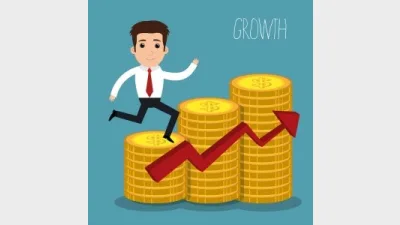Does history suggest it’s time to reconsider growth stocks?



There are sound reasons why many high-quality growth stocks are expected to perform relatively strongly in the next phase of the economic cycle.
The indiscriminate sell-off in growth companies this year has extended beyond those with little or no cashflow and dubious business models, leaving some great companies priced at more attractive valuation levels. This implies higher potential returns over the medium-to-long term.
Investment textbooks tell us that value stocks generally outperform growth stocks in periods of rising interest rates and economic slowdowns. However, history tells us that investors who wait for certainty that the market has pivoted from favouring value back to growth are likely to miss the mark.
When interest rates rise to control inflation, growth stocks suffer from higher variable debt costs, which reduce company profits, especially hurting those with already-thin profit margins. Higher bond yields also increase a company’s equity discount rate, which reduces the present value of future earnings and thus its market value – this particularly impacts growth companies whose profits lie further out into the future.
Some pundits tip value stocks to continue to outperform growth as higher interest rates slow the economy. They suggest investors should favour a value strategy until the market starts to show signs of recovery, and only then should a portfolio be rebalanced towards growth stocks.
Data tells us a different story
This ‘recovery moment’ may arrive some time before the interest rate cycle peaks, because share markets are forward indicators of future economic health – markets look ahead towards the economic recovery, which follows the eventual downward turn in the interest rate cycle.
Moreover, the suggestion that growth stocks only begin outperforming value sometime after the maximum drawdown is not supported by historic data. The following chart shows how growth starts to outperform value (i.e. the growth-value relative performance line shifts to sloping upwards) either some time before, or at the point of, maximum market drawdown.
Source: Bloomberg and Pengana
In the tech wreck at the start of the millennium, growth began outperforming value 12 months before the market low in September 2002. Similarly, the February 2009 post-GFC market low was preceded by the start of growth outperforming value by a few months. The COVID-19 market correction bottomed in March 2020, having seen growth outperform value throughout the previous six months.
Unfortunately for investors and advisors, market lows and interest rate peaks can only be confirmed in hindsight. Yet recent share market history offers little support for ‘waiting until the maximum market drawdown has passed’ before investing in growth companies.
Long-term growth trends remain intact
Growth stocks are positioned to benefit from longer-term secular trends, which remain intact in the post-COVID world:
Working from home is here to stay: This brings growth opportunities for a wide range of disruptive businesses as people continue to work and shop at home, whilst consuming media, entertainment and dinner ‘from the couch’.
The decarbonisation of the global economy is now irrevocably underway: This is being accelerated by the US Inflation Reduction Act. The war in Ukraine may lead to higher fossil fuel prices and more coal production, but only in the shorter-term. Decarbonisation benefits companies in a range of sectors (e.g. electric vehicles, green project finance and renewable energy technology) that enjoy low sensitivity to the business cycle.
The trend for affluent professionals to delay starting families: This is expected to continue throughout the downturn. This will support secular growth in the demand for luxury goods and other consumer discretionary spending, much of which is supported by the resumption of leisure travel.
Other factors which may affect value stocks
It’s possible the good news is now fully ‘baked into’ current share prices. Continued outperformance of value stocks would require sustained outperformance in big sectors such as energy and financials.
Energy has been enjoying strong cash flows in recent times. However, share prices now reflect this, existing supply is already being expanded, and new supply will be added over the medium term. Eventually prices will either fall or windfall taxes may be imposed – as seen recently in Queensland and the UK.
Banking is set to be affected by higher interest rates. The banking sector is likely to face a slowing housing market with less new mortgage business. Over time, the impact of rising bad debts will further offset the benefit to banks of wider lending margins, which is brought by higher interest rates.
Not all corporate earnings are cyclical. A likely decline in household and corporate spending will have a direct impact upon company profits yet growth companies in healthcare, pharmaceuticals, property management, and agricultural technology are largely protected from any such fall in spending.
Implications for investors
All market cycles are unique, and only hindsight will reveal the perfect moment to tilt our portfolios back towards growth stocks.
However, historic data suggests waiting for certainty that markets have bottomed, and interest rates are again falling, may mean missing out on periods of strong share market returns (e.g. The MSCI World Growth Index (USD) outperformed its value equivalent by 5.0% in the 12 months before the September 2002 tech wreck market low, and by 3.49% in the following 12 months).
Investing in high quality growth companies, with moderate debt levels, has served as a good investment strategy for investors willing to ignore shorter-term market fluctuations. Such a strategy requires investing for the long term and recognising that well-managed companies which grow earnings over time can sometimes be poor short-term performers.
Tim Richardson is an investment specialist at Pengana Capital Group.
Recommended for you
As the industry shifts from client-centric to consumer-centric portfolios, this personalisation is likely to align portfolios with investors’ goals, increasingly reflect their life preferences, and serve as a gateway to rewards and benefits.
Managing currency risk in an international portfolio can both reduce the volatility, as well as improve overall returns, but needs to be navigated carefully.
In today’s evolving financial landscape, advisers are under increasing pressure to deliver more value to clients, to be faster, smarter, and with greater consistency.
Winning one premiership can come down to talent, luck, or timing but winning multiple ones indicates something deeper and successful is at play, writes Darren Steinhardt.











